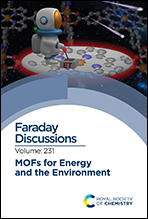Substituent effects on through-space intervalence charge transfer in cofacial metal–organic frameworks†
Abstract
Electroactive metal–organic frameworks (MOFs) are an attractive class of materials owing to their multifunctional 3-dimensional structures, the properties of which can be modulated by changing the redox states of the components. In order to realise both fundamental and applied goals for these materials, a deeper understanding of the structure–function relationships that govern the charge transfer mechanisms is required. Chemical or electrochemical reduction of the framework [Zn(BPPFTzTz)(tdc)]·2DMF, hereafter denoted ZnFTzTz (where BPPFTzTz = 2,5-bis(3-fluoro-4-(pyridin-4-yl)phenyl)thiazolo[5,4-d]thiazole), generates mixed-valence states with optical signatures indicative of through-space intervalence charge transfer (IVCT) between the cofacially stacked ligands. Fluorination of the TzTz ligands influences the IVCT band parameters relative to the unsubstituted parent system, as revealed through Marcus–Hush theory analysis and single crystal UV-Vis spectroscopy. Using a combined experimental, theoretical and density functional theory (DFT) analysis, important insights into the effects of structural modifications, such as ligand substitution, on the degree of electronic coupling and rate of electron transfer have been obtained.

- This article is part of the themed collection: MOFs for energy and environmental applications


 Please wait while we load your content...
Please wait while we load your content...